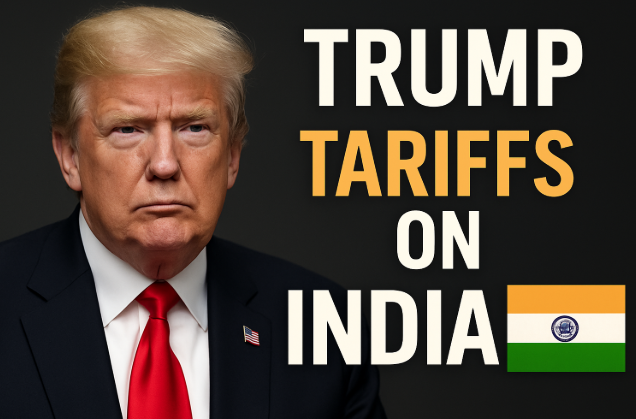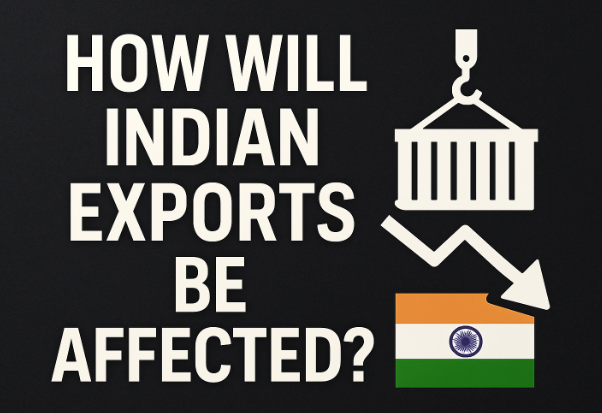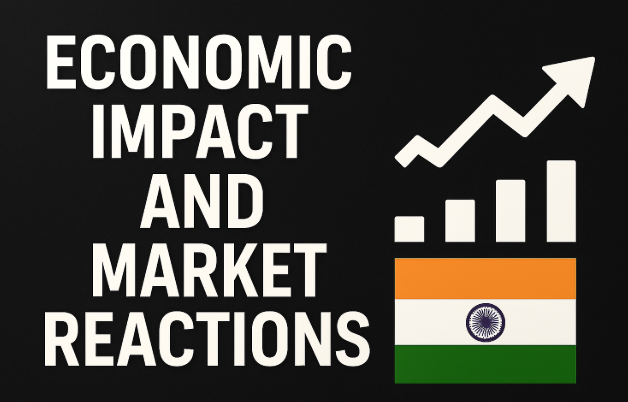Donald Trump Tariffs on India in 2025(US-India Trade War)

What Just Happened and Why It Matters(US-India Trade War)
In August 2025, the United States under President Donald Trump announced a massive 50% tariff on select Indian exports. This move came as a shock to both global markets and Indian exporters. The decision was justified by the Trump administration as a response to India’s continued oil imports from Russia, which the US believes helps finance Russia’s war in Ukraine. The Indian government has rejected this narrative, calling the tariff hike unjust and politically motivated.
In this blog, we break down what the Trump tariffs mean for India, which sectors are most affected, how the Indian government and political parties have reacted, and what might happen next in this growing trade conflict.
Also visit :- SBI CLERK NOTIFICATION IBPS CLERK NOTIFICATITON
Section 1: What Are the New Tariffs and Why Were They Imposed?
President Trump has imposed a 25% surcharge on top of the existing 25% base tariff, making the total tariff on Indian goods 50%. This is the highest tariff rate ever imposed by the US on a strategic trade partner like India.
According to the White House, the new tariffs are a punishment for India’s ongoing oil trade with Russia, which the US sees as helping fund Russia’s actions in Ukraine.
Key Tariff Details:
| Tariff Component | Rate |
|---|---|
| Base Tariff | 25% |
| Additional Surcharge | 25% |
| Total Tariff | 50% |
Reason Cited by US:
- India importing discounted oil from Russia
- Belief that these imports support Russia’s war economy
- Political pressure ahead of US elections
Section 2: How Will Indian Exports Be Affected?

The sectors hit hardest by these tariffs include textiles, pharmaceuticals, and agricultural exports. Together, these sectors account for billions of dollars in annual exports to the US.(US-India Trade War)
Indian Export Sectors Affected:
| Sector | Annual Export Value to US (Approx.) |
|---|---|
| Textiles & Apparel | $3.2 billion |
| Pharmaceuticals | $2.5 billion |
| Agricultural Goods | $1.8 billion |
| Others | $1.8 billion |
| Total Impact | $9.3 billion |
Exporters fear that US buyers may shift to other markets like Bangladesh or Vietnam due to the higher costs now associated with Indian goods.
Section 3: India’s Official Response
India has firmly opposed the new US tariffs. The Ministry of Commerce called the move “unjustified, unfair, and politically motivated.” Prime Minister Narendra Modi stated in a press briefing, “India will never compromise on the interests of its farmers and fishermen.”
India is also exploring the option of filing a formal complaint at the World Trade Organization (WTO) and is reviewing possible retaliatory tariffs on US goods.
Possible Actions by India:
- WTO complaint under trade violation clauses
- Retaliatory tariffs on select US imports
- Strengthening trade alliances with Russia, Brazil, and China
Section 4: Political Fallout in India(US-India Trade War)
Opposition leaders have used this opportunity to attack the ruling BJP government. Tejashwi Yadav criticized PM Modi, accusing him of “dancing to America’s tune” and failing to protect Indian interests.
Meanwhile, BJP leaders maintain that the government is taking all necessary steps to protect India’s sovereignty and economy. The tariff issue is likely to be a major talking point in the upcoming election cycle.
Political Reactions:
- Tejashwi Yadav: “Modi is weak; silent on America’s aggression”
- BJP: “India’s interests come first. This is election gimmickry by Trump.”
Section 5: Economic Impact and Market Reactions(US-India Trade War)

Despite the heavy tariffs, Indian financial markets showed resilience. The Nifty and Sensex closed slightly in the green the day after the announcement. Surprisingly, the Indian rupee gained slightly against the US dollar.
However, economic experts warn that if the tariffs remain in place long-term, India’s GDP growth could fall by up to 0.6% due to loss of export revenue.
Economic Indicators:
| Metric | Status Post-Tariff Announcement |
|---|---|
| Rupee vs Dollar | ₹87.69 (Slight appreciation) |
| Stock Market (Nifty) | Closed higher by 0.35% |
| Projected GDP Impact | -0.6% if tariffs stay for 12+ months |
Section 6: Strategic and Diplomatic Developments
India is already moving to strengthen ties with other global players. National Security Advisor Ajit Doval met Russian President Vladimir Putin in Moscow just hours after the US tariff announcement.
There are also signals of increased engagement with Brazil’s President Lula and quiet discussions about a possible visit to China for trade recalibration.
These moves indicate that India is not looking to back down but instead realign its global partnerships.
Strategic Shifts:
- Reinforcing India–Russia ties
- Brazil seen as key trade ally under South-South cooperation
- China engagement likely on the table for diversification
Donald Trump on India Tariff 2025: Explained
In August 2025, former U.S. President Donald Trump escalated tensions by announcing a 50% tariff on Indian exports, marking a major flashpoint in the ongoing US-India Trade War 2025. The tariff includes a base 25% duty plus an additional 25% surcharge, making it the highest levy the U.S. has imposed on a strategic ally like India.
Trump justified the move by criticizing India’s continued purchase of discounted oil from Russia, claiming it undermines U.S. sanctions and “funds Russia’s war in Ukraine.” This aggressive stance reflects Trump’s broader protectionist agenda and signals his return to hardline foreign policy ahead of the 2026 U.S. midterm elections.
India, however, has firmly rejected the rationale, calling the tariffs “unjustified and politically motivated.” The affected Indian sectors include textiles, pharmaceuticals, and agriculture, with a combined export value of over $9 billion. Analysts predict a potential 0.6% decline in India’s GDP if the tariffs persist.
The Donald Trump India tariff 2025 move is not just an economic decision—it’s a geopolitical signal. As India explores new alliances with Russia, Brazil, and China, the long-term implications of this trade war could reshape global trade balances in the years to come.
India-Russia Oil Trade in 2025: A Strategic Partnership Under Global Scrutiny (500 Words)
The India-Russia oil trade has become one of the most discussed aspects of global geopolitics in 2025, especially after the escalation of the US-India Trade War 2025 triggered by Donald Trump’s 50% tariff on Indian exports. At the heart of the controversy lies India’s decision to continue importing discounted crude oil from Russia, despite mounting Western pressure and ongoing sanctions imposed on Moscow due to its involvement in the Ukraine conflict.
Why India is Buying Oil from Russia
India is the world’s third-largest consumer of crude oil and imports over 80% of its oil needs. With global oil prices fluctuating and inflation being a major concern, India has been prioritizing energy security and economic affordability. Since early 2022, Russia began offering crude oil to India at heavily discounted rates—sometimes as much as 30% lower than global benchmarks like Brent crude.
For India, this was not just about savings; it was a strategic opportunity. The reduced prices helped the Indian government manage fuel subsidies, reduce import bills, and control inflation—all critical for a developing economy recovering from post-COVID and global recessionary trends.
The Payment Mechanism and Rupee-Ruble Trade
To bypass Western banking restrictions and sanctions on Russian oil, India and Russia developed a rupee-ruble trade mechanism. Payments for oil and other commodities were routed through Indian banks using local currencies or third-party currencies like the UAE dirham or Chinese yuan.
This system ensured that trade continued without relying on SWIFT or U.S.-dollar-based systems, which are under American control. While efficient, this arrangement angered Washington, which saw it as undermining global sanctions on Russia.
Strategic Benefits for India
- Diversification of Supply: India reduced its dependence on West Asian oil producers like Saudi Arabia and Iraq.
- Stable Prices: Russian oil allowed India to manage domestic petrol and diesel prices better than many Western economies.
- Stronger Bilateral Ties: The oil trade has deepened India-Russia relations, extending beyond energy to defense and space cooperation.
Global Criticism and Trump’s Reaction
The United States, especially under Donald Trump in 2025, has condemned India’s Russia oil dealings. Trump claimed that India’s oil purchases indirectly help Russia fund its war efforts in Ukraine. His administration used this argument to justify imposing steep tariffs on Indian goods, directly linking the Donald Trump India tariff 2025 decision to the India-Russia oil trade.
However, Indian officials have repeatedly clarified that their oil imports are legal, based on national interest, and not in violation of any international law. They emphasize that India is not part of NATO or any military bloc and is free to decide its foreign policy.
The Road Ahead
With global energy markets shifting and BRICS nations becoming more economically aligned, India’s oil trade with Russia is expected to continue—possibly even expand. India has shown no signs of backing down, and as new payment systems evolve, the country might further reduce its reliance on Western financial infrastructure.
In short, the India-Russia oil trade is more than just a commodity exchange; it is a symbol of strategic autonomy, energy pragmatism, and a changing world order—one where old alliances are being redefined and new power centers are emerging.
What Lies Ahead for India–US Trade Relations?
The tariff crisis marks a significant low point in India–US relations. While Trump’s move may be influenced by domestic political goals, its real impact will be felt by Indian exporters and global trade dynamics.
India is unlikely to yield under pressure. Instead, it may fast-track diversification of its trade portfolio by leaning more towards BRICS partners and creating new global trade blocs.
The coming months will be crucial in determining whether this conflict remains a temporary political maneuver or develops into a full-blown trade war.(US-India Trade War)
Top 10 FAQs on the US-India Trade War (2025)
Everything you need to know about the latest trade conflict between India and the United States
1. What is the US-India Trade War and when did it start?
The US-India Trade War refers to the escalating trade tensions between the United States and India, particularly in 2025, after former U.S. President Donald Trump imposed a 50% tariff on Indian exports. The conflict began when Trump cited India’s continued oil imports from Russia as a reason to penalize the country economically. India responded strongly, calling the move unjustified. The situation has since grown into a wider political and economic standoff, affecting billions in trade and reshaping international alliances.
2. Why did Donald Trump impose a 50% tariff on Indian goods?
Donald Trump claimed that India’s purchase of discounted oil from Russia was indirectly helping fund the war in Ukraine. As part of his broader foreign policy stance, he decided to penalize India by imposing a 25% surcharge on top of the existing 25% base tariff. This 50% tariff became the center of the US-India Trade War and was perceived by many as a politically motivated move ahead of the upcoming U.S. elections.
3. Which Indian sectors are most affected by the new tariffs?
The sectors most affected by the 50% tariff include textiles, pharmaceuticals, and agricultural exports. These industries are major contributors to India’s export economy and have a significant footprint in U.S. markets. With increased duties, U.S. buyers are now exploring alternatives from countries like Bangladesh, Vietnam, and Indonesia. This redirection could lead to job losses and revenue drops in India if the US-India Trade War continues.
4. How is the Indian government responding to the US tariffs?
India has firmly rejected the tariff hike. The Ministry of Commerce termed it “unfair and unjustified,” and Prime Minister Narendra Modi stated that India will not compromise on the interests of its farmers and workers. India is considering filing a complaint at the World Trade Organization (WTO) and may impose retaliatory tariffs on American goods. The government is also engaging with alternative trading partners to reduce dependence on the U.S. amid the US-India Trade War.
5. What role does India’s oil trade with Russia play in this conflict?
India has been purchasing discounted crude oil from Russia as part of its strategy to ensure energy security and manage fuel prices domestically. These deals, mostly done through rupee-ruble or non-dollar payment systems, bypass Western sanctions. The U.S. sees this as India undermining global efforts to isolate Russia. The US-India Trade War stems largely from this oil trade and its geopolitical implications.
6. Will this trade war impact common consumers in India or the US?
Yes, the effects of the US-India Trade War could trickle down to consumers. In the U.S., prices of Indian-made goods like garments, medicines, and specialty agricultural items may rise. In India, exporters facing reduced demand might cut back on production or lay off workers. While not immediate, inflationary pressure or supply disruptions can eventually affect everyday prices and product availability in both countries.
7. Is this trade war a short-term political move or a long-term policy shift?
There is still uncertainty about whether the US-India Trade War is temporary or the beginning of a long-term breakdown in trade relations. Given that Trump’s decision aligns with his election strategy, some analysts believe the tariffs could be reversed by a future administration. However, the growing shift toward strategic autonomy in both countries suggests this could mark the beginning of a long-term realignment in global trade dynamics.
8. How has the stock market reacted to the US-India Trade War?
Interestingly, the Indian stock market has shown resilience. The Nifty and Sensex closed slightly positive after the tariff announcement. However, long-term investor confidence may waver if the US-India Trade War escalates further. Currency markets also remained largely stable, with the rupee gaining slightly against the dollar, reflecting confidence in India’s economic fundamentals despite geopolitical pressures.
9. What are India’s alternative trade strategies amid this trade war?
India is rapidly diversifying its trade portfolio. Strategic meetings have already taken place with Russian President Vladimir Putin, and increased cooperation is expected with countries like Brazil and China. India is also boosting its role within BRICS and the Global South to counterbalance U.S. dominance. These moves reflect a broader shift driven by the ongoing US-India Trade War and India’s pursuit of greater economic independence.
10. What is the global reaction to the US-India Trade War?
Global reaction has been mixed. While some Western nations support the U.S. stance, others, particularly in Asia and Africa, view India’s position as justified and rooted in national interest. Economists and trade experts warn that such bilateral conflicts could weaken multilateral systems like the WTO. The US-India Trade War is being closely watched as it may redefine how emerging economies navigate future trade pressures from global superpowers.
The US-India Trade War of 2025 is more than just a tariff dispute—it’s a reflection of shifting global alliances, competing economic strategies, and the rising assertiveness of emerging powers like India. Whether this situation escalates or cools down will depend on future diplomacy, political leadership, and how global trade partners respond in the coming months.(US-India Trade War)

Pingback: Mortgage Rates Fall: Latest Figures, Market Impact, and What Homebuyers Should Do Now - mineVerse360